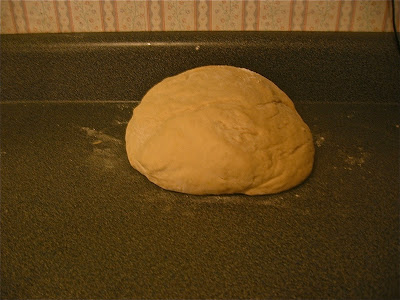Wednesday, December 15, 2010
Prepping and Pocketknives
Monday, December 13, 2010
132 pages of Spring


Thursday, December 2, 2010
Butchering Day 2010

Tuesday, November 16, 2010
My Grandma's Coffee Cake






Tuesday, November 2, 2010
Winterizing the garden

Temps are starting to dip a bit here in St.Louis. October 30 is our average 1st frost date, and last Thursday the 28th Jack Frost showed up right on time. This past weekend was the first time in over a month that we weren't out of town or doing something at school, so I finally had time to clean up around the 'burbstead. I puled out the last of the tomato plants, put the cages and hoses away, and put up a row of hoops over the bed of winter greens. I mowed the grass, leaves and all, and filled the two semi-raised beds with the clippings so it could all compost in place over the winter. Das Cluck Haus is back in the garden where it gets moved around all winter long. It's kinda odd to look out at the space that was so packed full of vegetation just a few weeks ago and see it more or less cut back and bare now. Everything is cyclical though, and my mind has already started planning for the end of winter and the beginning of next spring. Oh the possibilities...

Wednesday, October 27, 2010
The other side of crazy...


Tuesday, August 31, 2010
Sunset for the Summer garden


Wednesday, August 4, 2010
Homesteading as art

Sunday, July 25, 2010
Book Shelf : The Big Picture





Sunday, July 11, 2010
The Tomatoes come rolling in...

Friday, July 9, 2010
My current nemesis


Friday, July 2, 2010
Another post, another month




Thursday, June 3, 2010
Eating Seasonally and the 1st Tomato of the year

Tuesday, June 1, 2010
'Burbstead Supper






Monday, May 31, 2010
It's a Madhouse!!!

Holy Crap! It's been over 3 weeks since I posted anything on here. Between the end of my school year, my boys finishing kindergarten, an out of town family get together, a painting commission...yeesh. The 'burbstead has taken as much of a backseat as the blog. The garden got weedy, the chicken run was about a week and a half behind schedule getting moved (and it began stinking worse than it should have), and the yard got so overgrown that we could have baled hay if we'd have had a tiny little baler.
Friday, May 7, 2010
Dinner Movies
This past week I had the chance to go see a screening of the movie “Fresh” at a local brewery (Schlafly’s). It was presented by the St.Louis chapter of Slow Food International. It was described as the sequel to “Food Inc”, and I’d been wanting to see it for while. If you haven’t seen either film, I’d highly recommend both. They’re similar in the sense that they both hit the same major points: Interviews with Michael Pollan (author of “The Omnivore’s Dilemma” and “In Defense of Food”) and Joel Salatin (owner of Polyface Farms and author), unsettling hidden camera footage of CAFO’s and meat packing plants, portraits of farmers trapped in the industrial agriculture system, and breakdowns of just how unhealthy and unsustainable the American diet is. There is, however, a noted difference in the focus of each movie as well.
“Food Inc” is primarily a scathing indictment of our modern food system. It spends the bulk of the film exploring the nutritional, environmental, and ethical shortcomings of how we get our daily sustenance. Monsanto’s role in promoting GMO’s and monopolizing of the seed industry is condemned (something that has provoked a rather vehement response from Monsanto). There’s a heart-breaking scene involving a woman who became a food safety advocate to congress after the death of her son due to tainted meat. Over all, it’s a pretty bleak picture. Salatin’s Polyface Farm and the corporate organic dairy Stonyfield Farms (which is owned by Dannon corporation) are held up as two examples of how things can be improved, but the thrust of the movie is more heavily on what’s wrong with the system.
“Fresh” starts off with a condensed version of much of the material that is covered in “Food Inc”, but it then shifts to highlighting examples of people who are working to change the system. Polyface Farm is again featured, and rightfully so. Salatin has positioned himself as one of the chief spokespeople for small-scale, diversified, ecologically sensitive agriculture. He’s developed a fantastic system, and his passion for what he does is clearly evident when he speaks about his farm. The Ozark Mountain Pork Cooperative, a collection of small-scale pork producers in Missouri and The Hen House Grocery Stores in Kansas City are also featured. The highlight, for me though, was Will Allen’s Growing Power organization in Milwaukee, WI.
Will Allen is a former professional basketball player who began Growing Power in the early 90’s on 3 acres in urban Milwaukee. Since then, it has grown into a network of city farms that cultivate something like 100 acres in Milwaukee, and they’re expanding into Chicago. Will is putting together an organization that grows food, teaches skills, and builds communities. While I don’t think that there is one, right solution to the problems that we are facing, Growing Power is certainly on the right track.
As I said, I enjoyed both films. Neither one really presented me with much new information. I had already read books by Pollan and Salatin. I was familiar with the local food movement. Mostly it was neat to see an issue I was interested in and passionate about presented in an engaging and entertaining format. However, if the only people who see these films are those who are already committed to changing the status quo, then not much is going to change. We need to use movies like these to introduce our friends and family members to this very important issue. In that respect, I think “Fresh” might be more effective at persuading otherwise uninterested people. “Food Inc” is full of good information, much of it likely shocking to folks who haven’t given their food much thought. However, I think “Fresh” does a better job of showing the problem, and then giving lots of inspiring examples of alternative systems (and without alternatives, you’re just bitching into the wind).
So go get some snacks that you grew yourself, invite some friends over, and watch something that will spark more thoughtful conversation than 90% of what comes out of Hollywood these days. It might just be the start of a meaningful change in your community.
Tuesday, May 4, 2010
'Burbstead Breakfast

Monday, April 26, 2010
Harvesting..finally


Thursday, April 15, 2010
Mending Fence pt.2


Wednesday, April 7, 2010
Flashback: Hog Butchering 2009
 The Crew: Buster, Jon, Uncle Rick, Me, Tater Tot, Dad, Uncle Dean, Wingnut, Alex, Jackson, Erik, Rob *DT is missing
The Crew: Buster, Jon, Uncle Rick, Me, Tater Tot, Dad, Uncle Dean, Wingnut, Alex, Jackson, Erik, Rob *DT is missingLast Fall, on the day after Thanksgiving, while most Americans were participating in the vulgar ritual of conspicuous consumption known as "Black Friday", I had the pleasure of helping my family to butcher 3 hogs that my dad had been fattening up since the previous Spring. It was a lot of work, but it didn't seem hard working with brothers and cousins and uncles. I vaguely remembered butchering from when I was little, but that was almost 25 years ago. It was fun and gratifying to be involved in the process as an adult.










